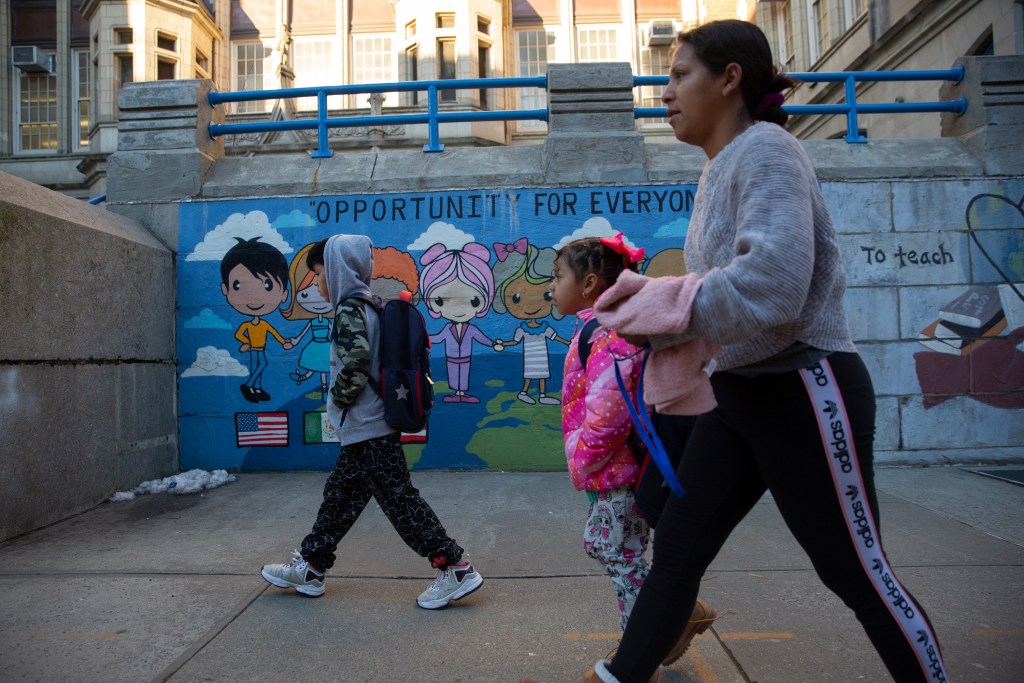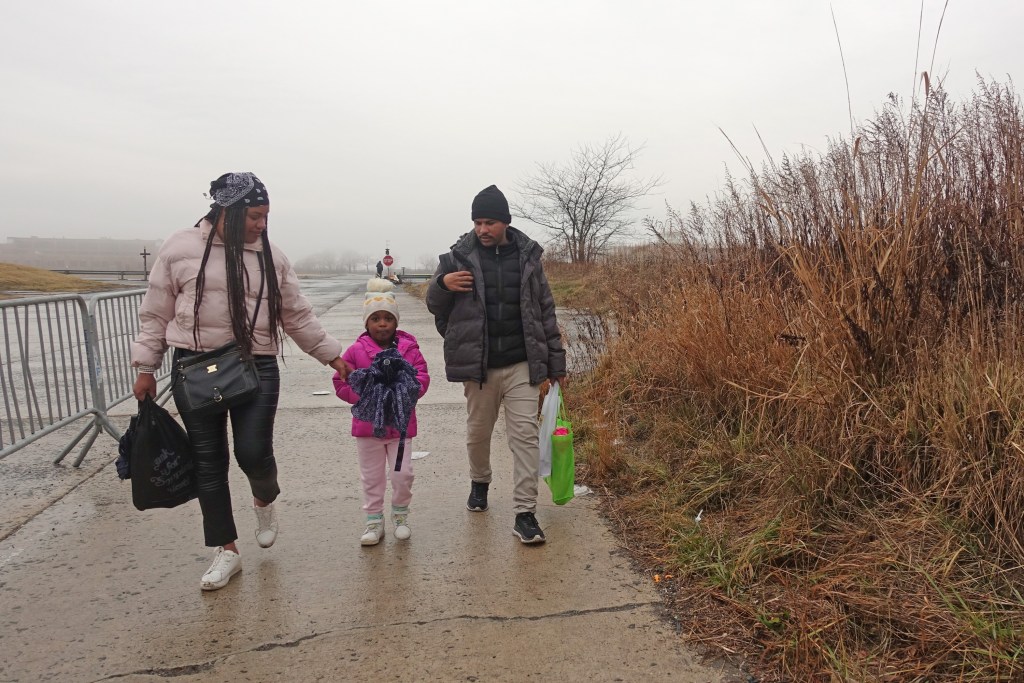Almost Half the Families Who Got 60-Day Eviction Notices Moved Out of Shelters
Earlier data showed that 29 percent of migrant families who got such notices switched to other shelters, while 16 percent remained in their original shelter.

Beatriz walks with one of her two daughters in Midtown while they were staying in a migrant family shelter, December 12, 2023. Photo by Gwynne Hogan/THE CITY
By Gwynne Hogan, The City, and Michael Elsen-Rooney, Chalkbeat
This article was originally published on by THE CITY
This article is part of an ongoing collaboration between Chalkbeat and THE CITY.
Beatriz, a Venezuelan mother of two young girls, got a 60-day notice to leave their Midtown migrant shelter last November.
The next day, she said, she was out hunting for apartments.
Working under the table in an Irish pub in Hell’s Kitchen, she’d been able to save some money, pooling it with her boyfriend and a cousin and his family. It was enough for the upfront costs to rent a three-bedroom apartment in Crown Heights they would all share. By the time her 60 days ran out, Beatriz and her girls had already moved out.
“We’re totally thankful,” Beatriz, who asked that her last name be withheld fearing immigration consequences, said in Spanish. “We’ve been given so much.”
Beatriz is among the first swath of migrant families with children to see their time in city shelters run out under a newly implemented city policy for migrant families in certain shelters. Notices started coming due in early January, and of the around 7,500 parents and children who reached their 60-day limit, half have moved out, according data through late February from the mayor’s office.
A further breakdown of the data on the 60-day policy released by New York City Comptroller Brad Lander last month found that of about 4,750 families whose time had expired through early February, 29 percent of them, or about 1,300 families, reapplied for shelter and were transferred to new shelters. The remaining 16 percent stayed in the same shelter where they were originally placed.
Among those who’ve gotten the notices include families like Beatriz’s who came in the fall of 2022, and had more than a year to find work and make connections in New York City.
But many who received the notices have entered the migrant shelter system since the rule has been in place, like families living at the sprawling tent facility at Floyd Bennett Field, or those at a recently opened family shelter in an old warehouse in Clinton Hill, who’ve had much less time to get their bearings in a new country.

The mayor’s office didn’t return a request for additional comment on the new data, but members of the Eric Adams administration have repeatedly defended the shelter stay limits, crediting them for driving down costs. They also say the policy is keeping the number of migrants in city shelters – which hovers at around 64,000 people — from continuing to grow. The numbers have even slightly dipped in recent weeks, despite more than a thousand newcomers arriving each week.
For adult migrants who are subject to strict 30-day shelter limits, with days- or weeks-long waits to get another cot, many have resorted to sleeping on the streets or trains, in overcrowded mosques, or unsanctioned commercial spaces. This week, Gothamist reported on one couple living in a school bus.
The Adams administration has repeatedly said its main goal is not to have families with children sleeping on the streets. In all, city officials said they’ve given 9,100 families shelter eviction notices so far. While some like Beatriz have landed on their feet, critics of the 60-day policy say many more parents and children who can’t afford to move out have been put through unnecessary turmoil.
“The 60-day shelter limit for families with children is one of the cruelest policies to come from City Hall in generations, evicting families from shelter in the middle of winter, and displacing kids from their schools in the middle of the school year,” said Lander, who has promised to investigate the policy. He pointed out City Hall has relatively little information on what happens to migrants when they leave shelters.
“Where did those nearly 2,500 parents go? Were they in a dangerously overcrowded basement? Were they sleeping on the street? We have no idea.”
Families Going Dark
Schools with migrant students forced to move because of the 60-day rule have been grappling with the logistical and emotional fallout of the disruptions.
“Just said goodbye to another four newcomers who are moving away after being with us for a year,” said one Manhattan principal, who spoke on the condition of anonymity. “Lots of tears from the kids and adults.”
Upper West Side parent Naveed Hasan, who sits on the city’s school board, the Panel for Educational Policy, has been part of an informal group of parents, school staff, and local elected officials working to find students who disappear suddenly from classes.
“It’s really like families going dark and then leaving people really confused. Where are they, and how can we help them?” Hasan said. “And I think this is sort of the intended effect of a policy.”
Testifying at a City Council hearing Friday, Molly Schaeffer, the head of the city’s office of Asylum Seeker Operations, said that 90 percent of children who were evicted in the month of January remained in their same school, though she didn’t give specifics. “We really did prioritize education and the education of the youngest children when making these types of choices and moves,” she said, adding the office tried to keep families in the same borough as their youngest child’s school.

Schools that recently got influxes of new students are already seeing them transferred to shelters in other parts of the city, leaving staffers with whiplash.
“In a month we had more than 50 students…and now I don’t know what’s going to happen with them,” said Carolina Zafra, a teacher at P.S. 46 in Clinton Hill neighborhood, among several schools in the area that received a sudden surge in students, following the opening of a new shelter for families in a converted warehouse.
School staffers knew the new students were subject to the 60-day shelter stay limit, but were holding out hope that city officials wouldn’t enforce it, Zafra said.
The school wrote letters for families to bring back to the shelter showing they were enrolled in a nearby school in the hopes it might get them a reprieve. But when teachers came back from mid-winter break this week, they found that many of their students had already been moved. Zafra has one student who’s now commuting to the school from Manhattan and she heard about another living by JFK airport.
“I’m more concerned about all the emotional distress those children already experienced and now again moving them from something I thought was settled for them,” she said.
One mom who arrived from Venezuela in December and enrolled her two kids at P.S. 46 said her family was transferred from the Hall Street shelter to a shelter in Midtown Manhattan last week.
The mom, who spoke on the condition of anonymity, said she never considered transferring her kids to a new school, even though her commute is now close to an hour.
“They have a lot of patience with the children,” she said of the school, in Spanish. “I didn’t want to change their school because they feel good there.”
Homeless students in New York City are entitled to transportation under federal law so that they can remain in the same school if they move. Kids and parents in temporary housing are eligible for free MetroCards, and younger students can also get assigned to school bus routes, though that process can take some time.
But the mom said their MetroCards are still pending, and since the family has no income to pay the fares, they often have to sneak through open emergency gates. Her husband has already received a fine for doing so.
Still, the Venezuelan mom considers herself lucky compared to other families from the school who were placed in shelters even further away, she said.
‘I Felt Such Relief‘
Among those 16 percent of families who’ve been able to remain in their shelters, according to the data from the comptroller, many are living at the remote tent shelter located at Floyd Bennett Field. Some describe their extended stay there as both a blessing and a curse.
Geraldine, a 38-year-old mother of three from Venezuela, who moved into Floyd Bennett Field last December, said getting used to the tents was a challenge: the long walks in the cold across a vast marshland to the nearest bus stop, the bathrooms and showers in trailers outside of the living quarters, the lack of privacy and constant cries of colicky children. The disruptions during severe weather have also been hard, like the January evening when the city evacuated thousands of residents to a nearby school due to high winds.

Still, as her eviction date approached she prayed the family would get to stay put, dreading the disruption of packing up and starting again somewhere new. The family collected their belongings the night before their mid-February move-out day, still unsure what would happen. But when her husband checked in with staff the next morning, he was told they could get another 60 days in the same cubicle.
“I felt such relief,” Geraldine said, who asked that her full name not be used to protect her family’s identity. “We didn’t have to go all the way to [Midtown] with the kids,” she said, referring to the process of reapplying for shelter at the Roosevelt Hotel. Instead their kids continued at their schools without interruption.
“The idea is to finish our time here, save up money and move out,” she said.
‘I Feel Good, and I’m Afraid’
Beatriz’ hunt for their new home was difficult, as it is for many New Yorkers. She fronted $500 to someone promising an apartment and spent a day standing the rain outside what she thought was her new apartment in Astoria before realizing it was a scam.
When a rental finally came through, she and her daughters moved out little by little, shuttling their belongings on the subway over the course of several days. After the winter break, Beatriz pulled her kids out of school and transferred them to ones closer to their new Crown Heights home, unable to make the bi-borough commute. Her 7-year-old daughter seems to be adjusting, while her 11-year-old is having a more difficult time.
“She misses all her friends from class,” Beatriz said.
Beatriz relishes being able to cook for herself and the family again, something she couldn’t do for more than a year living in a hotel room. She’s enjoying the privacy and peace of having their own place. But she also feels the anxiety of so many New Yorkers living paycheck to paycheck, that a little disruption could lead to an inability to make rent and send her back to shelter.
“I feel good, and I’m afraid, at the same time,” Beatriz said. “And the fear, because if one of us loses our job, god willing, how would we pay rent?”
THE CITY is a nonprofit newsroom that serves the people of New York. Sign up for our SCOOP newsletter and get exclusive stories, helpful tips, a guide to low-cost events, and everything you need to know to be a well-informed New Yorker.
Related Stories
- Brooklyn’s Hall Street Migrant Shelter Grows to 3,000, Testing Neighbors in Clinton Hill
- Former Gowanus Brewery, Clinton Hill Warehouse Slated to Become Migrant Shelters
- Migrants Sell Snacks in Downtown Brooklyn While Waiting on Work Permits
Email tips@brownstoner.com with further comments, questions or tips. Follow Brownstoner on Twitter and Instagram, and like us on Facebook.









What's Your Take? Leave a Comment